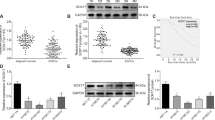Abstract
Background
Esophageal squamous carcinoma (ESC) is one of the most fatal malignancies worldwide with increasing occurrences yet poor outcome. MicroRNAs were reported to play roles in ESC.
Aims
We aimed to understand how miRNAs affect the radiotherapy resistance of ESC.
Methods
MicroRNA assays, real-time PCR, and Western blot were performed for expression analysis of miR-93 and BTG3. Luciferase activity assay was conducted with mutated B-cell translocation gene 3 (BTG3) 3′-UTR sequence in the 3′ end of luciferase sequence with miR-93 inhibitor. ESC cells were treated with irradiation (IR) and clonogenic assay was utilized to detect the cell viability. Human ESC xenograft mouse model was established and subjected to target IR treatment followed by tumor size analysis.
Results
MiR-93 was decreased and BTG3 was increased in ESC cells, with negative correlation of their expression in ESC tissues. MiR-93 directly targeted BTG3 3′-UTR by luciferase activity assay. Either miR-93 inhibition or BTG3 overexpression decreased radiation resistance. Furthermore, miR-93 inhibition suppressed radiation resistance through BTG3.
Conclusions
Direct downregulation of BTG3 by miR-93 is able to render ESC resistant to radiotherapy, and both BTG3 and miR-93 may potentially serve as clinical markers for ESC and contribute to the treatment of ESC.






Similar content being viewed by others
References
Huang FL, Yu SJ. Esophageal cancer: risk factors, genetic association, and treatment. Asian J Surg. 2016. doi:10.1016/j.asjsur.2016.10.005.
Lin Y, Totsuka Y, Shan B, Wang C, et al. Esophageal cancer in high-risk areas of China: research progress and challenges. Ann Epidemiol. 2017;27:215–221.
Gou WF, Yang XF, Shen DF, Zhao S, et al. The roles of BTG3 expression in gastric cancer: a potential marker for carcinogenesis and a target molecule for gene therapy. Oncotarget. 2015;6:19841–19867.
Du Y, Liu P, Zang W, Wang Y, et al. BTG3 upregulation induces cell apoptosis and suppresses invasion in esophageal adenocarcinoma. Mol Cell Biochem. 2015;404:31–38.
Sharova E, Grassi A, Marcer A, Ruggero K, et al. A circulating miRNA assay as a first-line test for prostate cancer screening. Br J Cancer. 2016;114:1362–1366.
Bahrami A, Aledavoud SA, Anvari K, Hassanian SM, et al. The prognostic and therapeutic application of microRNAs in breast cancer: tissue and circulating microRNAs. J Cell Physiol. 2017. doi:10.1002/jcp.25813.
Gu J, Wang Y, Wu X. MicroRNA in the pathogenesis and prognosis of esophageal cancer. Curr Pharm Des. 2013;19:1292–1300.
Liu ZG, Jiang G, Tang J, Wang H, et al. c-Fos over-expression promotes radioresistance and predicts poor prognosis in malignant glioma. Oncotarget. 2016;7:65946–65956.
Zheng W, Skowron KB, Namm JP, Burnette B, et al. Combination of radiotherapy and vaccination overcomes checkpoint blockade resistance. Oncotarget. 2016;7:43039–43051.
Nair DV, Reddy AG. Laboratory animal models for esophageal cancer. Vet World. 2016;9:1229–1232.
Crescenzi M, Persano L, Esposito G, Zulato E, et al. Vandetanib improves anti-tumor effects of L19mTNFalpha in xenograft models of esophageal cancer. Clin Cancer Res. 2011;17:447–458.
Iorio MV, Croce CM. MicroRNA dysregulation in cancer: diagnostics, monitoring and therapeutics. A comprehensive review. EMBO Mol Med. 2012;4:143–159.
Hausser J, Zavolan M. Identification and consequences of miRNA-target interactions–beyond repression of gene expression. Nat Rev Genet. 2014;15:599–612.
Kohlhapp FJ, Mitra AK, Lengyel E, Peter ME. MicroRNAs as mediators and communicators between cancer cells and the tumor microenvironment. Oncogene. 2015;34:5857–5868.
Paladini L, Fabris L, Bottai G, Raschioni C, et al. Targeting microRNAs as key modulators of tumor immune response. J Exp Clin Cancer Res. 2016;35:103.
Fang L, Du WW, Yang W, Rutnam ZJ, et al. MiR-93 enhances angiogenesis and metastasis by targeting LATS2. Cell Cycle. 2012;11:4352–4365.
Dews M, Homayouni A, Yu D, Murphy D, et al. Augmentation of tumor angiogenesis by a Myc-activated microRNA cluster. Nat Genet. 2006;38:1060–1065.
Ansari MH, Irani S, Edalat H, Amin R, Mohammadi Roushandeh A. Deregulation of miR-93 and miR-143 in human esophageal cancer. Tumour Biol. 2016;37:3097–3103.
Yoneda M, Suzuki T, Nakamura T, Ajima R, et al. Deficiency of antiproliferative family protein Ana correlates with development of lung adenocarcinoma. Cancer Sci. 2009;100:225–232.
Yamamoto N, Uzawa K, Yakushiji T, Shibahara T, et al. Analysis of the ANA gene as a candidate for the chromosome 21q oral cancer susceptibility locus. Br J Cancer. 2001;84:754–759.
Lin TY, Cheng YC, Yang HC, Lin WC, et al. Loss of the candidate tumor suppressor BTG3 triggers acute cellular senescence via the ERK-JMJD3-p16(INK4a) signaling axis. Oncogene. 2012;31:3287–3297.
Ren XL, Zhu XH, Li XM, Li YL, et al. Down-regulation of BTG3 promotes cell proliferation, migration and invasion and predicts survival in gastric cancer. J Cancer Res Clin Oncol. 2015;141:397–405.
Yu J, Zhang Y, Qi Z, Kurtycz D, et al. Methylation-mediated downregulation of the B-cell translocation gene 3 (BTG3) in breast cancer cells. Gene Expr. 2008;14:173–182.
Majid S, Dar AA, Ahmad AE, Hirata H, et al. BTG3 tumor suppressor gene promoter demethylation, histone modification and cell cycle arrest by genistein in renal cancer. Carcinogenesis. 2009;30:662–670.
Majid S, Dar AA, Shahryari V, Hirata H, et al. Genistein reverses hypermethylation and induces active histone modifications in tumor suppressor gene B-Cell translocation gene 3 in prostate cancer. Cancer. 2010;116:66–76.
Lv Z, Zou H, Peng K, Wang J, et al. The suppressive role and aberrent promoter methylation of BTG3 in the progression of hepatocellular carcinoma. PLoS One. 2013;8:e77473.
Li C, Ding C, Chen T, Chen J, et al. Micro ribonucleic acid-93 promotes proliferation and migration of esophageal squamous cell carcinoma by targeting disabled 2. Thorac Cancer. 2015;6:524–533.
Author information
Authors and Affiliations
Corresponding author
Ethics declarations
Conflict of interest
None.
Electronic supplementary material
Below is the link to the electronic supplementary material.
Rights and permissions
About this article
Cite this article
Cui, H., Zhang, S., Zhou, H. et al. Direct Downregulation of B-Cell Translocation Gene 3 by microRNA-93 Is Required for Desensitizing Esophageal Cancer to Radiotherapy. Dig Dis Sci 62, 1995–2003 (2017). https://doi.org/10.1007/s10620-017-4579-x
Received:
Accepted:
Published:
Issue Date:
DOI: https://doi.org/10.1007/s10620-017-4579-x




